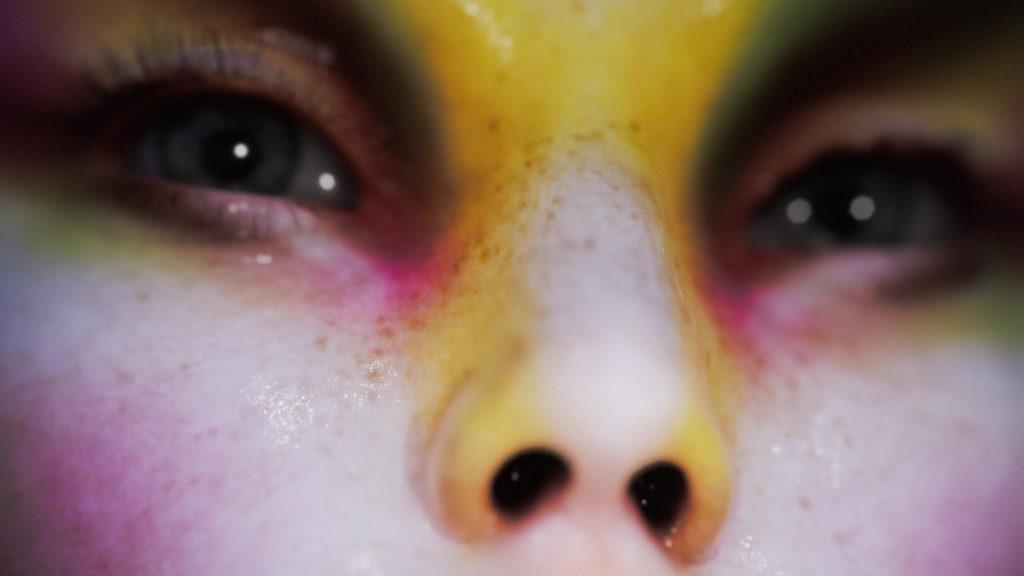Actual Objects open their Fact Residency with 30 minutes of frazzled Ableton gymnastics and a glimpse into the creative studio’s wider aesthetic universe.
Actual Objects describe themselves as an experimental, multidisciplinary creative studio, but if you asked any of the 12 or so artists, directors and programmers that make up the team what they spend most of their time doing, they would probably answer you with two words: world building. Founded in 2019 by husband and wife creative duo Rick and Claire Farin, alongside Rick’s childhood friend Nick Vernet, the studio emerged out of a shared interest in CGI, which they developed during their time enrolled in a graduate program at the Southern California Institute of Architecture, or SCI-Arc. It was there that they met Cole Daly and Case Miller, who together with graphic designer Collin Fletcher make up the core of the studio’s current iteration. Following a period of working out of their bedrooms, it was a group decision to move their computers into an office space in Los Angeles’ Chinatown that heralded the birth of Actual Objects. Bringing together a wide variety of disciplines, including Rick’s background making music as Eaves, Claire’s skills as a painter and Miller’s experience as a researcher and programmer, the team set out to change the aesthetic landscape of what computer generated visuals can do and how they can be applied. “We were trying to bring a longer, more developed art practice into what was going fast with digital art,” explains Claire, succinctly.

“The name Actual Objects comes from the idea that even though we’re making digital work, that’s sitting in the Cloud or whatever, it’s technically still physical. It’s a little laser etching on a piece of rare metal on a hard drive,
” explains Rick. “Part of what we want to do with our work is talk about the permanency of digital objects and the kind of resonance that those objects can have in the physical world.” Working with brands such as Nike, Hood By Air and Marine Serre and artists including Eartheater, Salem and Yves Tumor, Actual Objects have crystalised a singular, hypermodern aesthetic by bringing in a diverse array of references into a digital sphere. Less inspired by video games and bleeding edge graphics than they are by art house cinema, cultural theory and science fiction writing, Actual Objects seek to broaden digital horizons and redefine the kinds of worlds it’s possible to build. “It’s about trying to approach making work with computers with a certain kind of criticality and trying to rethink what those aesthetics could be,” says Rick. “We’re trying to create digital work that feels either somehow embedded in a kind of physicality, or is talking about that relationship.”

One fundamental pillar of Actual Objects’ wider practice is music. Rick’s soundtrack work with Berlin-based producer Theo Karon can be very much be understood as emerging out of the intricate, muscular productions he was making as Eaves, thick washes of sci-fi sound design, pummeling batteries of weaponised percussion and precision-engineered sample fuckery filling every inch of their digital topographies. “It’s all meant to fit in the same world,” says Rick. “One thing we’re really interested in from a soundtrack perspective is things feeling quite diegetic, sounds that feel like they’re part of the soundtrack, but also happening on screen.” Karon finishes Rick’s sentence: “sounds that bring their own context with them.” Their dizzying contribution to Fact’s mix series is a stunning showcase of this, fusing 30 minutes of frazzled Ableton gymnastics with our first glimpse of Actual Objects’ visual universe, as a virtual avatar curates the duo’s sounds in real time. “The audio is pretty much straight ripped, with a little bit of editing, from a live recording that Theo and I did when we opened up for Amnesia Scanner in LA,” explains Rick. “There’s music we wrote specifically for the show, but then there was this whole other project that ended up getting fucked up because of COVID that a lot of the music was taken from and was remixed into this live show context.”

“It’s this last remnant of a thing that really never got a chance to exist otherwise,” says Karon. “I love that it expresses very clearly that Rick and I are often coming at music making from just the most opposite technical angle possible, but with a lot of aesthetic compatibility.” Though sharing an interest in similar sounds, the two producers couldn’t be more different when it comes to actually making them. “I was shocked when I met Rick, I’d heard his music, I thought it was brilliant, and then I saw him working on it and he explained his process to me, and it’s all samples! It’s all like YouTube! I come from a very traditionalist background, I learned to record music on analog tape so it’s been immensely rewarding to work with Rick. There’s a purism in both of those schools and I think Rick and I have really managed to completely obliterate that demarcation and I think it’s quite evident in the music and that makes me very happy. There’s a tremendous amount of verisimilitude that happens where each of us responds to features in the process of the other that are unconscious to us individually and and the tension between those is fuel, it isn’t argumentative. It’s what compels it.”
Creative Direction – Actual Objects
Art – Claire Farin, Cole Daly, Rick Farin
Music – Rick Farin, Theo Karon
For more information about Actual Objects you can visit the studio website and follow the studio on Instagram.
Listen next: Fact Mix 827 – Angel D’lite




